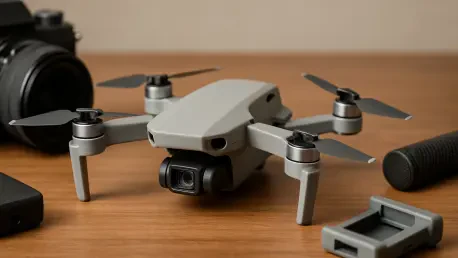In an era where content creation has become a cornerstone of digital expression, the demand for compact, powerful tools that can capture stunning visuals on the go has never been higher, and a new contender in the drone market promises to redefine what a sub-250g device can achieve. Blending professional-grade features with unparalleled portability, this latest release from a leading drone manufacturer, designed specifically with social media creators and hobbyists in mind, has sparked significant buzz for its ability to rival much pricier models while sidestepping many regulatory hurdles. With advanced imaging capabilities and innovative flight technology packed into a lightweight frame, it raises a compelling question about whether mini drones can now meet the needs of serious creators without the bulk or cost of larger alternatives. This exploration delves into the standout aspects of this cutting-edge device, evaluating its potential to become a game-changer for aerial videography and photography.
Breaking New Ground in Mini Drone Technology
Camera Capabilities That Rival High-End Models
The imaging system of this latest mini drone marks a significant leap forward for devices in its weight class, offering a 1-inch 50MP sensor that matches the quality found in much larger and more expensive counterparts. This setup, combined with 10-bit color depth and a specialized color profile, ensures that 4K video output captures intricate details in highlights and shadows, delivering results that stand toe-to-toe with professional-grade equipment. Such capabilities are particularly noteworthy for a drone under 250g, as they provide creators with the tools to produce cinematic content without needing to invest in bulkier, costlier options. This focus on high-quality visuals directly addresses the needs of social media enthusiasts who prioritize polished, eye-catching footage to engage their audiences.
Beyond raw image quality, the camera system introduces a unique feature with its three-axis gimbal, capable of a 225-degree roll rotation. This allows seamless transitions between horizontal and vertical shooting modes at full 4K resolution up to 60fps, catering specifically to platforms that favor diverse formats. Additionally, support for slow-motion recording at 4K 120fps and 1080p up to 240fps adds a layer of versatility for dynamic video production. For creators aiming to craft compelling narratives or high-energy clips, this functionality—rarely seen in drones of this size—offers a distinct advantage, enabling professional output without the complexity or expense of larger systems.
Flight Features Designed for Ease and Precision
Equally impressive are the advanced flight technologies integrated into this compact drone, which ensure both safety and precision during operation. Equipped with omnidirectional object sensing and front-facing LiDAR, the device can navigate complex environments while avoiding obstacles with remarkable accuracy. This feature is a boon for beginners and seasoned pilots alike, reducing the risk of crashes and allowing focus to remain on capturing the perfect shot. The refined 360° ActiveTrack subject tracking further enhances usability by maintaining reliable focus on moving targets, a critical asset for dynamic content creation in fast-paced settings.
Complementing these safety and tracking features is the drone’s lightweight design, weighing in at under 250g. This not only makes it highly portable but also exempts it from many regulatory restrictions that apply to heavier models, offering greater flexibility for casual and semi-professional users. Such accessibility means that creators can operate in a wider range of locations without the burden of complex licensing or compliance issues. The combination of cutting-edge flight assistance and regulation-friendly design positions this mini drone as an ideal tool for those seeking both performance and convenience in their aerial endeavors.
Value and Impact on the Drone Market
Pricing That Broadens Accessibility
One of the most striking aspects of this mini drone is its competitive pricing, which makes professional-grade features accessible to a broader audience of creators and hobbyists. The standard bundle is priced at £679 / AU$1,119, while a more comprehensive Fly More Combo, including extras like spare batteries, a charging hub, and ND filters, retails for £979 / AU$1,699. Although pricing for certain regions remains pending, these figures suggest a cost-effectiveness that undercuts many alternatives with similar capabilities. For those on a budget or just entering the world of aerial content creation, this affordability removes a significant barrier to accessing high-quality tools.
Moreover, the value proposition extends beyond mere cost to encompass the robust feature set packed into such an affordable package. When compared to drones costing several times more, this model offers a compelling balance of price and performance, challenging the notion that top-tier results require a hefty investment. This strategic pricing not only appeals to individual creators but also signals a shift in the industry toward democratizing advanced technology, potentially reshaping purchasing decisions for a wide range of users looking to elevate their content without breaking the bank.
Redefining Expectations for Compact Drones
The introduction of such a feature-rich mini drone has sparked discussions about its broader implications for the industry, particularly in how it blurs the line between consumer and professional equipment. By embedding high-end camera systems and sophisticated flight features into a sub-250g frame, the device sets a new standard for what compact drones can achieve, potentially disrupting the market for larger, pricier models. This trend reflects a growing emphasis on portability and ease of use, catering to a generation of creators who value mobility as much as quality in their tools.
Looking back, the release of this drone proved to be a pivotal moment, as it demonstrated that size no longer dictates capability in aerial technology. The industry took note, with manufacturers likely spurred to innovate further in the mini drone segment. For creators and hobbyists, the takeaway was clear: investing in this device offered a forward-thinking solution that balanced performance with practicality. As the market continued to evolve, the challenge remained to monitor how subsequent releases would build on this benchmark, ensuring that accessibility and innovation stayed at the forefront of drone development for years to come.









